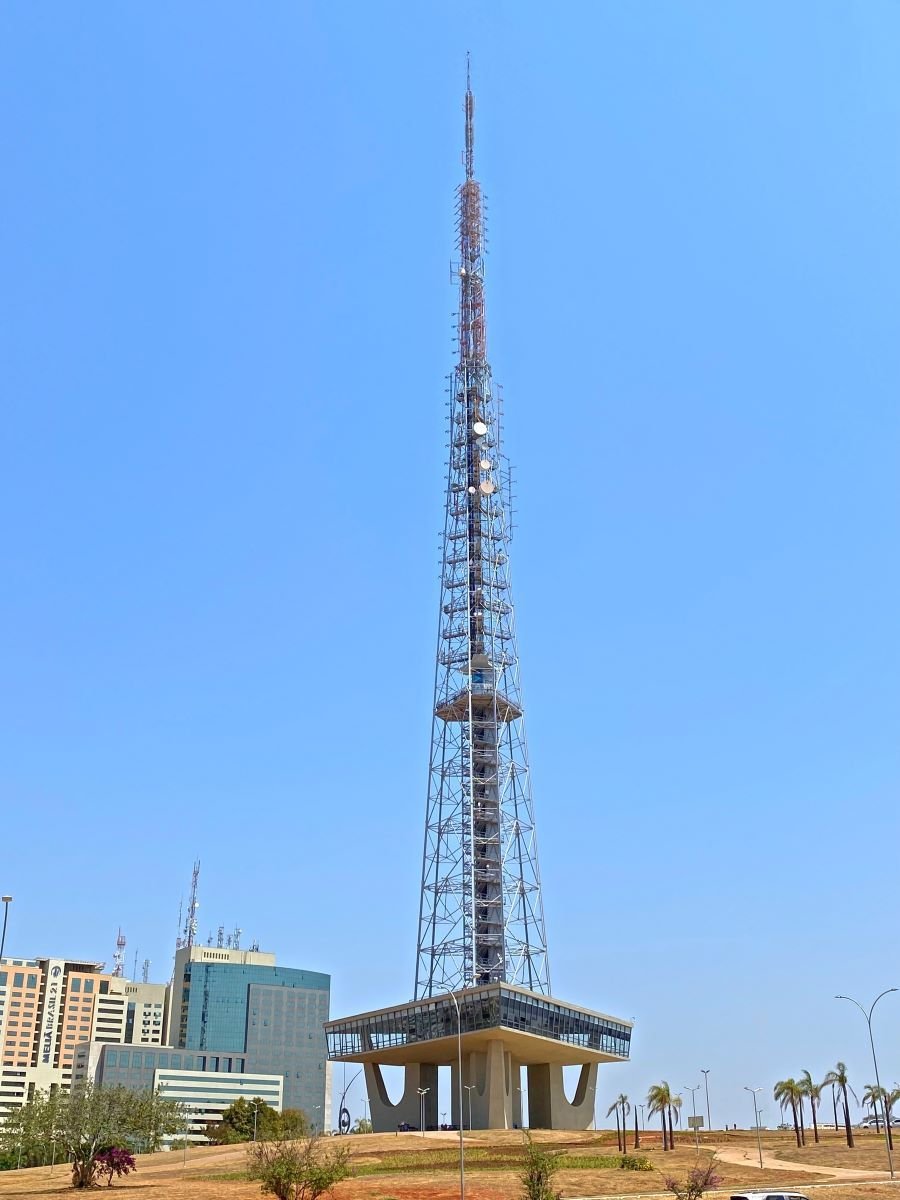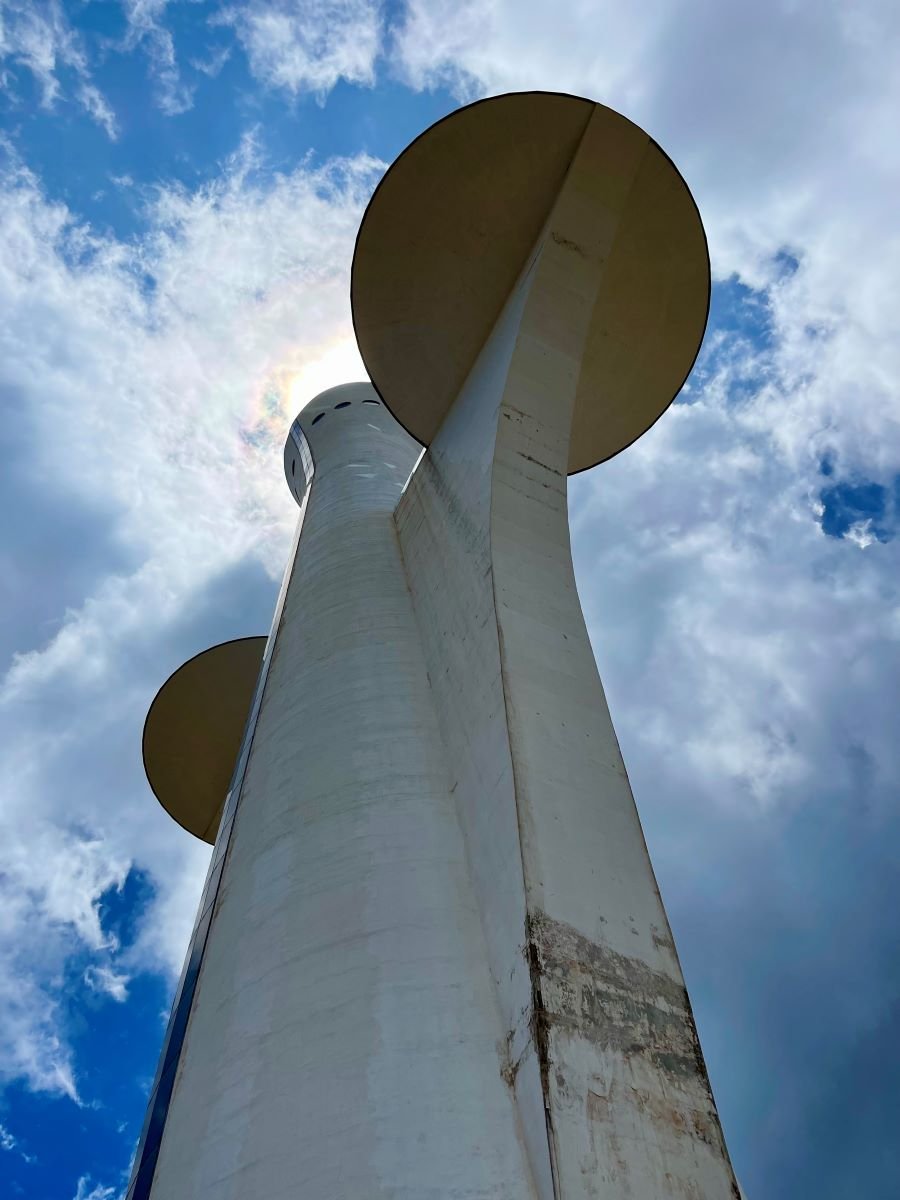The Flower of the Cerrado: Oscar Niemeyer’s last gift to Brasília
A huge sculpture dominates the skyline north of Brasília. At least that’s the first impression. It looks like a giant flower—my first thought when I first saw it was, what is that? I have to get up close to see it! In fact, it is a tower purpose-built to transmit digital television signals, but like everything in this city of unique architectural design, it adds beauty while performing its function. After years of closure to the public due to the need for renovations and further complicated by the pandemic, the tower reopened and I was able to see it in person in December 2022.
The digital tower seen from the nearest road
The first TV tower in Brasília was inaugurated in 1967 to transmit the analog signal of what was then the only national television network, Rede Globo. The military dictatorship that began with the 1964 coup d’etat understood how useful television would be for shaping public opinion, and wide coverage of the TV signal would increase uptake. Once people had something to watch they would be anxious to buy a television. Antennas sprouted on rooftops and the era of TV Globo began in the relatively new capital city of Brasília.
The analog tower is located on the Eixo Monumental, the monumental axis, the central avenue that features the congress building, presidential offices, supreme court and the long line of stacked dominoes that are the ministry buildings. Urban designer Lúcio Costa set the seat of government in a privileged position with views of the surrounding hills. The TV tower sits on an elevated area of the avenue’s green central swath, with a garden designed by famed artist and landscape architect Roberto Burle Marx that sadly remains a work in progress. A huge fountain was added to the complex in 2010 to commemorate the 50th anniversary of the city’s inauguration.
With the proliferation of television stations and cable service in the 2000s, a new solution was needed to deliver digital signals. Silvestre Gorgulho, former Secretary of Culture for the Federal District (the seat of Brasília, called the DF, as the United States’ District of Columbia is DC) was told by a television station in 2007 that they needed to build a new tower to transmit digital signals. He recognized this would be just the beginning of a proliferation of independent TV towers marring the beauty of Brasília’s skyline. Gorgulho called Oscar Niemeyer, the famed architect who designed all of Brasília’s iconic buildings, and asked if he would take on a project to design a tower to be used by all TV stations. Niemeyer enthusiastically agreed to take on the project, and met with TV engineers to learn the technical parameters needed for optimal function of the tower.
Niemeyer delivered the plans in 2008 and construction began that same year. It was a 110 meter tower on a cylindrical base, supported by two rods and sprouting two domes that protrude from the structure. The effect was that of a flower with two petals, and it became affectionately known as a flor do cerrado, the flower of the cerrado, a name affectionately adopted by the architect himself. Cerrado is difficult to translate, often literally called “the bush,” but it refers to all the vegetation of the interior of Brazil.
The altiplano, or high plains, as seen from the observation level of the tower
Niemeyer wanted visitors to feel awe at seeing the tower up close, and imagined them wondering “what they would see up there.” The second emotion would hit upon reaching the observation area and seeing the spectacular 360-degree views of Brasília’s manmade lake Paranoá and the city of Brasília, with the surrounding countryside laid out below.
In 2009, Oscar Niemeyer mused on his vision for the tower in its completed form which at the time was under construction:
"When I started thinking about this tower, scheduled for 170 m in height, I felt the only solution to be adopted should be the use of the reinforced concrete technique in all its richness, but especially considering the expected height, which made [reinforced concrete] even more attractive and justifiable. And we think of it . . . including a large space where, enjoying the fantastic panorama it allowed, visitors could stop a little, taking a drink, talking, commenting on the beauty of this capital that in that moment will be even more beautiful to them. . . I look again at the tower's surprising façade and it amazes me as its structure is simple . . . two supports at the base that little by little separate to a smooth curve supporting the two planned areas [the petals], on the one hand, a lounge and bar and on the other side an area for expositions. I look again at the projected tower façade and the form it will create in space and the technical simplicity that was part of its planning.”
The technical design may have been simple and elegant, but construction proved challenging and required an iterative process building the tower in layers, in order to achieve stability. The difficulties caused the project to be delayed and increased its cost significantly. The curves support two geodesic-like domes with no visible supporting structures. Near the top of the tower the observation area is a full circle with 14 round windows, each two meters in diameter.
A Flor do Cerrado was finally inaugurated on April 21, 2012, commemorating the 52nd anniversary of the inauguration of Brasília itself. The inauguration was attended by its architect Oscar Niemeyer, and would be his last project, as he died in December of the same year at the age of 104.
The plan was for the tower to be a tourist magnet, featuring restaurants and events in the two domes that Oscar Niemeyer envisioned. Unfortunately, funding was not provided to follow through on these goals, and a lack of resources caused degradation due to failures of simple maintenance. While the structure was not at risk of collapse, there were cracks and disfiguring of the surfaces that urgently needed attention. As a result, the tower was closed to the public in 2016.
Prospects for reopening were further compounded by the Covid pandemic which resulted in nearly 800,000 deaths, similar on a population basis to the number of deaths in the United States, and most likely an undercount in terms of the number of lives lost in Brazil. The pandemic devastation in Brazil is regarded by most experts as due to mismanagement by the administration of far-right immediate past president Jair Bolsonaro, who called Covid “a little flu” and discouraged vaccination while promoting quack drugs as cure-alls. Commerce in Brasília and the country in general came to a virtual standstill that dragged on for a year and a half.
I had always wanted to visit the Flor do Cerrado, and since its construction I had found my eye drawn to its graceful presence on the northern horizons of the Federal District. I was in Brasília from October to December of 2022 for the release of a lua ao avesso, the Portuguese translation of my historical novel set in mid-century Brazil, The Moon Is Backwards. My mother-in-law lives in Sobradinho, a satellite city north of Brasília that is quite close to the digital TV tower. On a whim I drove by one afternoon and discovered it was open!
The digital tower as seen from the parking lot
Looking up at the tower from the ground next to its base makes one fully appreciate the spectacular artistic and architectural achievement of Niemeyer and the construction engineers.
Looking up at the tower from below
There are still no restaurants and there is only one display area where one checks in for a tour. The base of the tower is a reflecting pool, with a ramp leading up to the entrance and lobby with several elevators. The first level on the tour are the two domes that form the petals of the flower. A visit to a dome is eerily like entering an alien spacecraft, with the unbroken expanses of glass triangles framing the gorgeous views.
The entrance to one of the “petals,” glass domes that sprout from the stem of the flower
The view from inside one of the domes
Looking up at the tower from inside one of the domes
Stepping back on the elevator it’s a quick ride up to the observation area, the highest point allowed for visitors. There the visitor is in awe of the 360 degree views of the surrounding area.
A raincloud delivers a downpour to the city of Brasília
The docent who guides the tour, Rafael, is knowledgeable and passionate about the tower and it’s clear he enjoys seeing people’s reactions to the spectacular vistas from the observation area, just as Oscar Niemeyer imagined. I was no exception; to look out at the vast altiplano, the high plains, green from winter rains with clouds riding in the majestic skies above, is an awe-inspiring experience. I took advantage of the photo opportunities at every turn, reflecting on the remarkable architectural achievement and the beauty of the cerrado. Yet another reason to love Brasília.
Panoramic image of one of the domes. Thanks to tour docent Rafael for his help with the shot.










